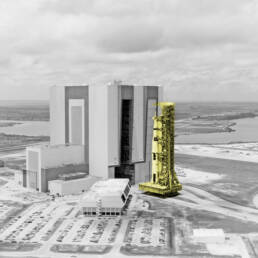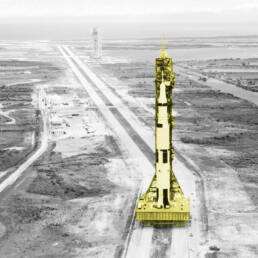“It was a 110-meters-tall behemoth” (Woods 2010, 22)
Three stages overall, from the F-1 engines to the launch escape system on the top.
In February 1969 the Saturn V assembly operation began inside the Vertical – later “Vehicle” –Assembly Building – VAB – at NASA’s Kennedy Space Center in Florida. It was 160 meters tall, 218 meters long and 158 meters wide, and it enclosed 3,664,883 cubic metersof space. Reyner Banham discussed this building at the very beginning of his masterpiece, Megastructure: “Though it contained the largest single room ever built by men – big enough to contain its own weather as well as fully assembled space rockets upright on their transporters – the scholarly query as to whether it was a megastructure always brought the baffled but decisive answer No” (Banham 1976, 7). In fact, it was used as a comparative element to state the definition of one of the most relevant term in the history of architecture.
However, we are looking to what came out of the VAB on the morning of May 20, 1969. The rocket was not alone. It was coupled with the mobile launch system designed by the Wernher von Braun’s team. The system was composed by a 2,700-tonne diesel-powered crawler/transporter – moved by tracked tractor units derived from heavy open-cast mining equipment – and a tower even taller than the rocket sprouted from one end of the platform. The crawler/transporter carried the combined load of 5,700 tonnes along the 5.5-kilometre way to the launch complex. The whole system was 136 meters tall.
Really it was a white-and-red behemoth walking around the Florida landscape.
Architecture and the space race share a common frame of technological inventions. Moreover, in architecture we have tried to metabolize the well-known impact of the “machine” as a whole theme. “By randomizing circulation, short-circuiting distance, artificializing interiors, reducing mass, stretching dimensions, and accelerating construction, the elevator, electricity, air-conditioning, steel” and considering that “the new infrastructures formed a cluster of mutations that induced another species of architecture” we can see, according to Rem Koolhaas [later K], that since one hundred years “the combined effects of these inventions were structures taller and deeper-Bigger-than ever before conceived” (Koolhaas 1995, 494-517). Bignessbecame the core of a specific phase of K’s theoretical reflection, as it was inside his “retroactive manifesto” – Delirious New York (Koolhaas 1978). Five fundamental theorems are the cornerstones of this necessarytheory, which however has even wider implication. There are operative terms within K’s statements, but Bigness mainly is a reasoning on the principles of architecture and their capability to deal with the evolution of the contemporary society.
The launch structure shared by all missions of the Apollo program belongs to the theme of Bigness not only because it shares with it some fundamental technical advances, nor because it responds directly to some of the Koolhaasian theorems – the first and the fifth above all – but something less explicit.
K, as the most practical of contemporary visionaries, expresses Bigness as a tool for a revolution in the definition of disciplinary paradigms. The sixth theorem – never written, but implicit in K’s reasoning – is the symbolic/iconic character of Bigness and its related objects, that are incarnation of it. Only this character can contain the communicative effectiveness of the values highlighted by K. It is a concept quite different from the theme of ideologies, which K often refers to.
Bigness presents a certain degree/kind of synthesis which is what most qualifies potential icons. Bigness can be, in a sense, the toposof a unity capable of managing great complexity, through a powerful communicative and symbolic device. Apollo program’s structures – in particular those of Apollo 11 – perfectly represent the iconic value contained in K’s theory of Bigness. In fact, Apollo 11 – as an event and as a research topic – perfectly depicts not only the characteristics of the object, but also what has occurred as an effect of it, especially about the impact on the public. Through it one can have a complete account of this kind of phenomenon.
The Apollo program represents an absolutely collective feat and result in which “Untold Stories” are often hidden (Takemura 2019). In the same way, buildings also arise from the action – or better, co-action – of people who constitute a community during the time of the commitment. Limits and dynamics of this temporary community stand out progressively as the analysis of any design process is deepened.
So, the cross-link between Apollo 11 and architecture is not only tied to a symbolic value, or to the metaphor of new architectural paradigms: in respect to the concept of “collective” it seems natural to partially overthrow the logic of the K’s text that seems to look more to the collective useof Bigness than on its real fulfillment. When he refers more directly to the creators of Bigness, he limits himself to considering the merely operational/professional plan, rather than thinking of the community of “builders” in the broad sense. The re-calibration towards people and facts mostly neglected or forgotten unites architecture with the history of the Apollo.
Apollo 11 and Bigness share, before anything else and as the cause of all other themes, the fact of being the products of mankind. Apollo 11 and Bigness share, before anything else and as the cause of all other issues, the fact of being the products of a human effort. Since people act through mostly repeated patterns, common traces are found not only through the series of factors highlighted up to now, but even before in the desire to leave tangible signs, as greater as possible.Features change through time and along the evolution of the tools – both practical and theoretical – available, but that purpose remains. Each of the many traceable authors for this kind of work has this kind of aspiration – despite K’s claim that inside the frame of Bigness “the architect is no longer condemned to stardom” (Koolhaas 1995, 513).
The years following the end of the Second World War were evidently fertile ground for this kind of reflection to the point that we cannot be surprised that the pre-elaboration of Delirious New York and its interpretative point of view is a story-manifesto – The Surface – of the summer of 1969 (Mastrigli 2014).
After all, within the twentieth century we saw all kinds of rockets and behemoths.
A big rocket © Luigi Mandraccio
Reference List
- Banham, Reyner. 1976. Megastructure: Urban Futures of the Recent Past. London: Thames and Hudson.
- Koolhaas, Rem. 1978. Delirious New York: A Retroactive Manifesto for New York. New York: Oxford University Press.
- Koolhaas,Rem, and Mau,Bruce. 1995. S,M,L,XL.New York: The Monacelli Press.
- Mastrigli, Gabriele. “Rem Koolhaas and the Bourgeois Myth of New York,” Socks-Studio (5 December 2014). http://socks-studio.com/2014/12/05/rem-koolhaas-and-the-bourgeois-myth-of-new-york-gabriele-mastrigli-2013/
- Takemura, Alison F. “Curator of Apollo’s Untold Stories,” Slice of MIT (4 December 2019). https://alum.mit.edu/slice/curator-apollos-untold-stories?utm_source=twitter&utm_medium=social&utm_campaign=slice
- Woods, W. David. 2010. How Apollo Flew to the Moon. New York: Springer
Photo Credits
- Photo: Picture of the rocket’s system just outside VAB, edited by the author; the original was KSC-69PC-238, “Aerial view of the Apollo 11 Saturn V rollout from the Vehicle Assembly Building. 20
Author: J. L. Pickering
Source: https://www.youtube.com/watch?v=PUW89NpDYJw
Year: May 1969
- Photo: The rocket’s system on its was along Kennedy Space Center, picture edited by the author; the original was 69-H-910, “The Apollo 11 Saturn V moves down the crawler-way toward the launch pad at one mile per hour.
Author: Scans by Kipp Teague
Source: https://www.youtube.com/watch?v=PUW89NpDYJw
Year: 20 May 1969
Luigi Mandraccio
Architect and Ph.D. student. He pursues intellectual curiosity at the turn of researches and projects – but also as wasting time’s excuse.
On Instagram: @arkigigi


